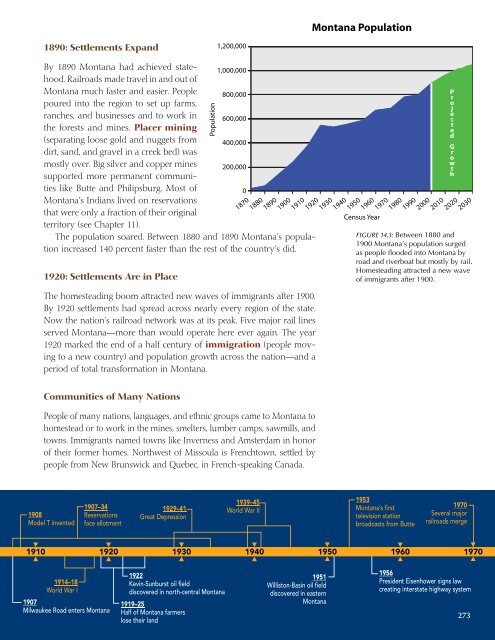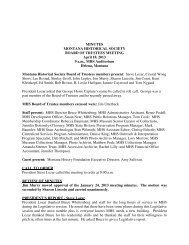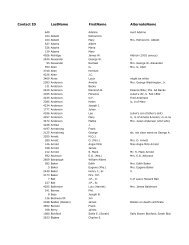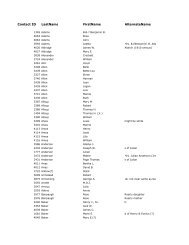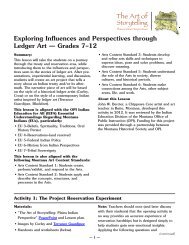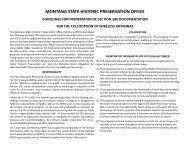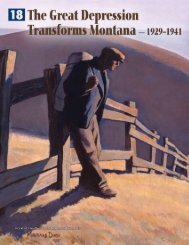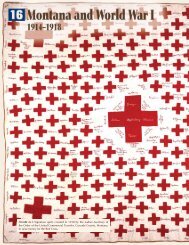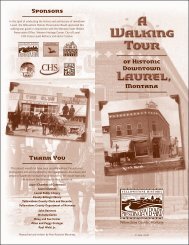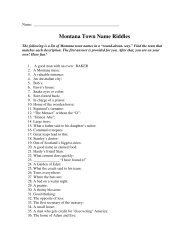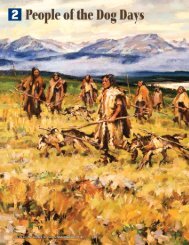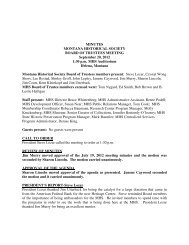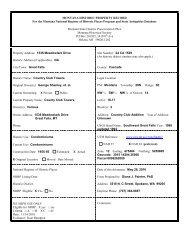Great Falls Montana: Its Situation, Surroundings - Montana Historical ...
Great Falls Montana: Its Situation, Surroundings - Montana Historical ...
Great Falls Montana: Its Situation, Surroundings - Montana Historical ...
You also want an ePaper? Increase the reach of your titles
YUMPU automatically turns print PDFs into web optimized ePapers that Google loves.
1890: Settlements Expand<br />
By 1890 <strong>Montana</strong> had achieved statehood.<br />
Railroads made travel in and out of<br />
<strong>Montana</strong> much faster and easier. People<br />
poured into the region to set up farms,<br />
ranches, and businesses and to work in<br />
the forests and mines. Placer mining<br />
(separating loose gold and nuggets from<br />
dirt, sand, and gravel in a creek bed) was<br />
mostly over. Big silver and copper mines<br />
supported more permanent communities<br />
like Butte and Philipsburg. Most of<br />
<strong>Montana</strong>’s Indians lived on reservations<br />
that were only a fraction of their original<br />
territory (see Chapter 11).<br />
The population soared. Between 1880 and 1890 <strong>Montana</strong>’s population<br />
increased 140 percent faster than the rest of the country’s did.<br />
1920: Settlements Are in Place<br />
The homesteading boom attracted new waves of immigrants after 1900.<br />
By 1920 settlements had spread across nearly every region of the state.<br />
Now the nation’s railroad network was at its peak. Five major rail lines<br />
served <strong>Montana</strong>—more than would operate here ever again. The year<br />
1920 marked the end of a half century of immigration (people moving<br />
to a new country) and population growth across the nation—and a<br />
period of total transformation in <strong>Montana</strong>.<br />
Communities of Many Nations<br />
People of many nations, languages, and ethnic groups came to <strong>Montana</strong> to<br />
homestead or to work in the mines, smelters, lumber camps, sawmills, and<br />
towns. Immigrants named towns like Inverness and Amsterdam in honor<br />
of their former homes. Northwest of Missoula is Frenchtown, settled by<br />
people from New Brunswick and Quebec, in French-speaking Canada.<br />
1908<br />
Model T invented<br />
1914–18<br />
World War I<br />
1907–34<br />
Reservations<br />
face allotment<br />
1907<br />
Milwaukee Road enters <strong>Montana</strong><br />
1929–41<br />
<strong>Great</strong> Depression<br />
Population<br />
1922<br />
Kevin-Sunburst oil fi eld<br />
discovered in north-central <strong>Montana</strong><br />
1919–25<br />
Half of <strong>Montana</strong> farmers<br />
lose their land<br />
1,200,000<br />
1,000,000<br />
800,000<br />
600,000<br />
400,000<br />
200,000<br />
0<br />
1870<br />
1939–45<br />
World War II<br />
1951<br />
Williston-Basin oil fi eld<br />
discovered in eastern<br />
<strong>Montana</strong><br />
<strong>Montana</strong> Population<br />
1880<br />
1890<br />
1900<br />
1910<br />
1920<br />
1930<br />
1940<br />
1950<br />
1960<br />
1970<br />
1980<br />
1990<br />
2000<br />
2010<br />
2020<br />
2030<br />
Census Year<br />
FIGURE 14.3: Between 1880 and<br />
1900 <strong>Montana</strong>’s population surged<br />
as people fl ooded into <strong>Montana</strong> by<br />
road and riverboat but mostly by rail.<br />
Homesteading attracted a new wave<br />
of immigrants after 1900.<br />
1953<br />
<strong>Montana</strong>’s fi rst<br />
television station<br />
broadcasts from Butte<br />
1970<br />
Several major<br />
railroads merge<br />
1910 1920 1930 1940 1950<br />
1960 1970<br />
1956<br />
President Eisenhower signs law<br />
creating interstate highway system<br />
273<br />
1 3 — H O M E S T E A D I N G T H I S D R Y L A N D 2 7 3<br />
P rojecte<br />
d<br />
G ro<br />
w th


